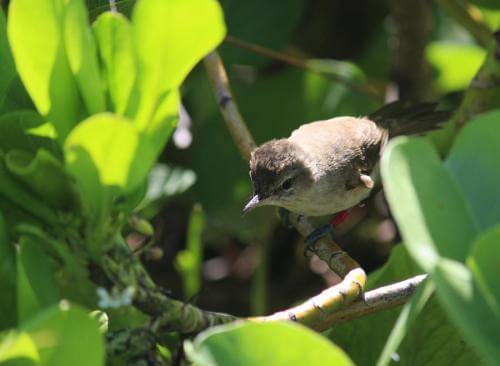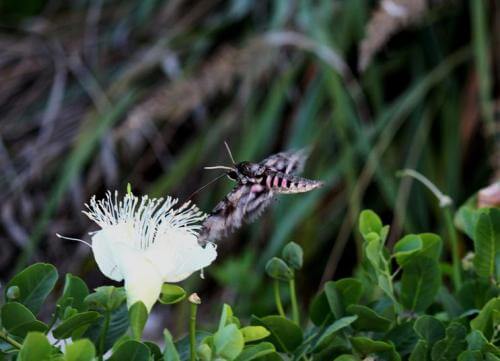On Laysan Island: A New Cycle Begins
July 29 to August 11, 2013
Andrea Kristof
After a brief vacation from the demands of parenting, the Millerbirds of Laysan Island (in Hawai'i) are emerging from their molting period and initiating the fourth wave of breeding this calendar year. The fledglings from the 2013 breeding season, which only two weeks ago wandered through the Millerbird core habitat carefree and unhindered, are now being actively chased to the margins of territories by the resident breeders. The adult males have resumed singing; pairs have been observed carrying nesting material; and we have located ten new nests.
But perhaps the most exciting and anticipated event of this two-week interval was the addition of 2013 “hatch-years” (birds that were hatched in the 2013 breeding season) to the Millerbird chorus. On August 9, we observed the first hatch-year male, a banded bird that fledged from the Northwest Bowl territory on April 14, displaying territorial behavior and singing a fully developed song. This individual was embroiled in a very lengthy dispute with an unbanded male (probably another hatch-year) over a patch of shrubby real estate in the northeastern part of the Millerbird core habitat, far from his natal territory in the northwestern core region.
Nature sighting of the week
The warm weather of August has brought with it an explosion of insect activity on Laysan Island. The house flies—which until recently had been abundant but manageable—now blanket our arms, faces, hats, and backpacks in writhing black masses. A Millerbird field technician might hope that the silver lining of this discomfort would be that this inescapable insect buffet would entice the insectivorous Millerbirds to come closer and facilitate re-sighting their bands. Unfortunately, although we've observed Millerbirds dining on the flies surrounding the carcasses of dead seabirds, they have not yet expressed the same enthusiasm for the clouds of flies that encircle us.
Another element of the insect assemblage that has recently come into prominence is the sphinx moth (Family Sphingidae). The sphinx moth is a large moth—with its wings extended, it is nearly half the size of the palm of my hand—with ornately patterned cream-colored wings and pink stripes adorning the sides of its abdomen. Although typically a rare sight on Laysan, these creatures have become a common daily occurrence over the past couple weeks in the naupaka that makes up the core Millerbird habitat.
We've caught the sphinx moths while mist netting, watched them make long distance flights over the naupaka, and also observed them foraging among the beach morning glory flowers by hovering at a distance of over an inch in front of the flower and extending their long proboscis to retrieve the nectar. Habitat destruction likely caused the extinction of the majority of Laysan's native insects. This moth, like most insects currently found on Laysan, is introduced.
Other bird news
The number of albatrosses on the island has diminished markedly as this breeding season comes to a close. But Laysan Island is never short of avian activity. The population of shorebirds has begun to swell along the lakeshore, a prelude to the winter migration. So far, we've primarily encountered the most common migrants to Laysan—Pacific Golden-Plovers, Ruddy Turnstones, and Wandering Tattlers—but a couple of Sanderlings have also appeared this week.
Brown Noddies are now hatching in large numbers. Wedge-tailed Shearwater chicks have finally begun to emerge from their eggs. Grey-backed Tern juveniles are flying alongside their parents. We suspect William, our Masked Booby friend, has been taking secret practice flights away from his hatch area, but he returns there daily to see if his parents will continue to bring him food. A few adult Bonin Petrels reappeared on the island for the first time since late June to prepare for this winter's breeding season.
In two weeks' time, so much can change. Please check back with us to see what's happening!
 Andrea Kristof is a long-time Laysan camp manager and new member of the Millerbird team.
Andrea Kristof is a long-time Laysan camp manager and new member of the Millerbird team.




















































